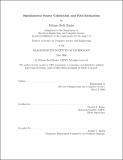Simultaneous sensor calibration and path estimation
Author(s)
Rudoy, Melanie Beth
DownloadFull printable version (496.8Kb)
Other Contributors
Massachusetts Institute of Technology. Dept. of Electrical Engineering and Computer Science.
Advisor
Charles E. Rohrs.
Terms of use
Metadata
Show full item recordAbstract
This thesis presents two topics related to the simultaneous calibration of a network of imaging sensors, i.e. cameras, and the recovery of the trajectory of an object moving among those sensors. The non-overlapping fields of view for the cameras do not cover the entire scene, and therefore there are time steps for which no measurements are available. A Bayesian framework is imposed on the problem in order to compute the MAP (maximum a posteriori) estimate, the solution that maximizes the probability of the sensor network configuration and target trajectory given the measurement set. The first topic discussed is model order reduction to decrease the number of unknown parameters in the motion and measurement models, thereby reducing the computational requirements of the optimization algorithm. It is possible to reduce the dimension of the search space, with no loss in accuracy, by treating the estimation of target's trajectory while it is outside the field of view of the network as an independent sub-problem that can be solved at a later time. Additionally, one can further reduce the dimension of the search space by taking advantage of the fact that the measurement noise is negligible compared to other sources of error in the problem, and subsequently the measurements can be treated as equality constraints in the optimization. (cont.) This second procedure yields results that are not equal to the solution determined by the original algorithm, with the magnitude of the difference dependent on the covariance of the original measurement noise. The second aspect of this thesis relates to improving the accuracy of the solution by taking further advantage of missing measurement information. The original algorithm may yield a solution that is infeasible with respect to knowledge of the times at which measurements occurred. The MAP estimate may place the trajectory of the target inside the field of view of one of the sensors at a time step for which no measurement is available. Three techniques that treat the missing measurements as additional constraints on the problem are presented. The first algorithm reformulates the problem as a mixed-integer nonlinear (non-convex) programming problem. The second algorithm systematically explores only feasible subsets of the search space, adding and removing constraints as needed according to a simple set of rules. The last algorithm discusses the use of circular constraints to approximate the actual sensor boundaries, which results in simpler problem formulation.
Description
Thesis (S.M.)--Massachusetts Institute of Technology, Dept. of Electrical Engineering and Computer Science, 2006. This electronic version was submitted by the student author. The certified thesis is available in the Institute Archives and Special Collections. Includes bibliographical references (leaves 73-75).
Date issued
2006Department
Massachusetts Institute of Technology. Department of Electrical Engineering and Computer SciencePublisher
Massachusetts Institute of Technology
Keywords
Electrical Engineering and Computer Science.